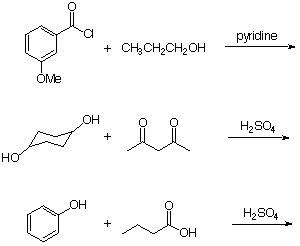
Week 5 Problem Set 30 BL (Esterification Reaction)
Useful Link: Refractometer
ATTN: answers to the below questions are due at the start of your lab period; these answers should be part of your pre-lab write-up.
1. What is the role of the concentrated sulfuric acid in this week's experiment? Can it be replaced by nitric acid? Explain.
2. Explain how the workup serves to isolate the ester. Supply a flow chart indicating in which layer the ester can be found at each step. (Hint: What organic compounds are present after the reflux?)
3. A student observes a refractive index of nD30=1.3422. What is the refractive index at 25 C? Which information does he get from the refractive index?
4. How does the yield (in g) for the esterification (of acetic acid with isoamyl alcohol) change if the student
a. adds 10% of the amount of sulfuric acid asked for in the procedure and runs the reaction for the same amount of time
b. adds 10% less acetic acid in her reaction
c. refluxes the mixture for a days instead of an hour
d. adds 20% more isoamyl alcohol
e. adds 10% sulfuric acid
f. runs the reaction at room temperature
5. Predict the major product of following reactions.

6. Do questions 4, 7, 8 and 11 on p. 140 in Landgrebe.
7. How many signals do you expect to observe in the 13C{1H}-NMR spectrum of teh following compounds: acetic acid, isopentyl alcohol, isopentyl acetate, sodium bicarbonate